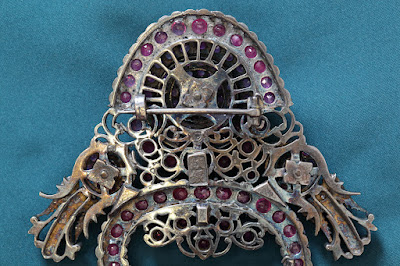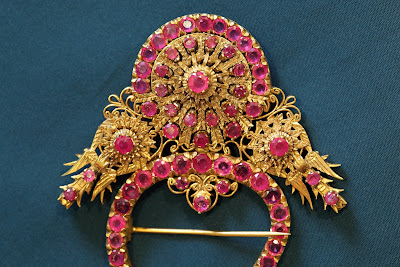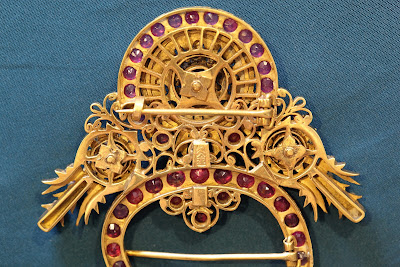From my research, there are several names for this unique item. Kerongsang or kerongsang serong or brooches or kerongsang rantai (if it's linked with chains to each brooch) was first favoured by the Penang Peranakans, but its use gradually spread to Malacca and Singapore. It is usually worn with a baju panjang. The kerongsang serong consists of a large paisley-shaped piece or kerongsang ibu (mother) that is teamed with two smaller brooches, each called the kerongsang anak (child), or kerongsang bulat (round), if they were round in shape.
Most of the diamonds found in old Peranakan jewellery are believed to have come from Banjarmasin in Southern Kalimantan, which have the only mines in the region. These intan or diamonds were typically of a yellow hue, described as warna air chempaka or "the aqueous hue of the chempaka flower". The diamonds would usually be rose-cut (hand cut) with a flat back and domed and faceted face. They were known as intan minyak. By the late 19th century, brilliant cut diamonds began to appear. These new brilliant cut diamonds or berlian have a pointed back, reflecting light entering the top of the gems and back out again, giving the sparkling effect we associate with cut diamonds today.
Here are shown a few sets of my kerongsang collection.
 Kerongsang with ibu and anak 1.
Kerongsang with ibu and anak 1.
-Front- -Back-
-Back- Closer look of the workmanship.
Closer look of the workmanship.
-Front- Closer look of the workmanship.
Closer look of the workmanship.
-Back- The mark at the back of the ibu kerongsang which is in Chinese character "紋銀", meaning "fine silver".
The mark at the back of the ibu kerongsang which is in Chinese character "紋銀", meaning "fine silver". Kerongsang with ibu and anak 2.
Kerongsang with ibu and anak 2.
-Front- -Back-
-Back- Closer look of the workmanship.
Closer look of the workmanship.
-Front- Closer look of the workmanship.
Closer look of the workmanship.
-Back- The mark at the back of the ibu kerongsang which is in Chinese character "紋銀", meaning "fine silver".
The mark at the back of the ibu kerongsang which is in Chinese character "紋銀", meaning "fine silver". Kerongsang with ibu and anak 3.
Kerongsang with ibu and anak 3.
-Front- -Back-
-Back- Closer look of the workmanship.
Closer look of the workmanship.
-Front- Closer look of the workmanship.
Closer look of the workmanship.
-Back- The mark at the back of the ibu kerongsang which is in Chinese character "久金", meaning "old gold".
The mark at the back of the ibu kerongsang which is in Chinese character "久金", meaning "old gold". Kerongsang with ibu and anak 4.
Kerongsang with ibu and anak 4.
-Front- -Back-
-Back- Kerongsang with ibu and anak 5.
Kerongsang with ibu and anak 5.
-Front- -Back-
-Back- Kerongsang with ibu and anak 6.
Kerongsang with ibu and anak 6.
-Front- -Back-
-Back- Kerongsang bulat 7.
Kerongsang bulat 7.
-Front- -Back-
-Back- Kerongsang Rantai with dragonflies 8.
Kerongsang Rantai with dragonflies 8. -Front-
-Front- -Back-
-Back- Closer look of the workmanship.
Closer look of the workmanship. Kerongsang rantai Melayu 9.
Kerongsang rantai Melayu 9. The detail of the workmanship.
The detail of the workmanship. The detail of the workmanship.
The detail of the workmanship. Kerongsang rantai 10.
Kerongsang rantai 10. Kerongsang rantai 11.
Kerongsang rantai 11. Kerongsang rantai 12.
Kerongsang rantai 12. Kerongsang rantai 13.
Kerongsang rantai 13.
(With the rantai or chain missing). Incomplete and broken ibu kerongsang.
Incomplete and broken ibu kerongsang.
-Front- -Back-
-Back- The detail of the silversmith work.
The detail of the silversmith work. The same incomplete and broken ibu kerongsang with also broken anak kerongsang.
The same incomplete and broken ibu kerongsang with also broken anak kerongsang.
-Front- -Back-
-Back-The reason I bought this incomplete and broken ibu kerongsang from an antique dealer in Malacca is due to its uniqueness and the detail of the silversmith work which is very hard to find elsewhere.
 Incomplete set of kerongsang, which only with one of the anak kerongsang.
Incomplete set of kerongsang, which only with one of the anak kerongsang.
-Front- -Back-
-Back- Incomplete set of kerongsang, which only with one of the anak kerongsang.
Incomplete set of kerongsang, which only with one of the anak kerongsang. Incomplete set of kerongsang, which only with one of the anak kerongsang.
Incomplete set of kerongsang, which only with one of the anak kerongsang. The mark at the back of the ibu kerongsang which is in Chinese character "紋銀", meaning "fine silver".
The mark at the back of the ibu kerongsang which is in Chinese character "紋銀", meaning "fine silver". The mark at the back of the ibu kerongsang which is in Chinese character "紋銀", meaning "fine silver".
The mark at the back of the ibu kerongsang which is in Chinese character "紋銀", meaning "fine silver".




































I have a piece of a all gold Ibu Kerongsang with the bird and prawns motif. Can you give me an estimate value of this piece
ReplyDeleteWell, I can't really tell you the value of your item unless I've touched or seen the pictures. Also, it depends to the size of the kerongsang and whether it is a solid gold or gilded silver.
DeleteIt is made of solid gold and the piece is about the same size of your photo of the "broken Ibu Kerongsang" Mine is in better condition with a pin at the back. Is this brooch is a rare piece ? I am seriously thinking of donating it to an Australian museum.
ReplyDeleteIndeed, all the genuine antique kerongsangs are consider rare and hard to find these days. But I've seen a few of it at the antique shops and my friend's personal collection. To talk about the value, the solid gold itself tells you more than I do. :) A very generous and great idea of what you are intending to do. At least it goes to somewhere where people will get the chance to appreciate the beauty and history of the item, rather than to people who just interested in cash money.....Great job.... I salute you....
DeleteThank you. I am going to write to the Gold Museum in Perth to find out if they are interested to have the piece. I know that it will be safe there. Sorry I do not trust our local museums and the last time my late father donated his gun and it has gone missing !
ReplyDeleteHullo, I would like to seek permission to use a few images from your excellent blog in a book that I am preparing. Could you reply to me at eckkheng@landmarkbooks.com.sg so that I can write you an email with details? Thank you.
ReplyDeleteHi I would like to know the rough estimate of the kerongsang I have in my possession. I will send a photo if you are able to assist. TQ
ReplyDeleteHi Would you be interested to purchase my kerongsang set?
ReplyDeleteBTW it is a set of ibu and 2 anaks. It is gilded silver with intans and rubies. Ibu is size of palm. Do let me know
ReplyDeleteRegards
Kartini
Hi, can i use ur image to put in my gallery? My email is kennethlamkokwei1987@gmail.com. =)
ReplyDeleteThanks for this blog, I really enjoyed reading your post.
ReplyDeleteDresser Scarves
Hello - I have an ibu and anak kerongsang set with intan very similar to the above. Around what decade, century would these have been made?
ReplyDeleteMy name is Shahrizan Abdullah. In my younger days I was an avid collector of antique kerosang jewellery. I have many pieces which I keep preciously and never worn before. But now, I think I shouldnt keep them anymore and wish to sell them to a genuine collector. Hope you can advise me. Please call me 012-2873016 .
ReplyDeleteHi, I recently inherited a set of the nyonya kerongsang serong. I'm rather baffled as to how it is worn as the pin goes from back to front. Would appreciate it much if you could post a few pictures to demonstrate how it's worn.
ReplyDelete